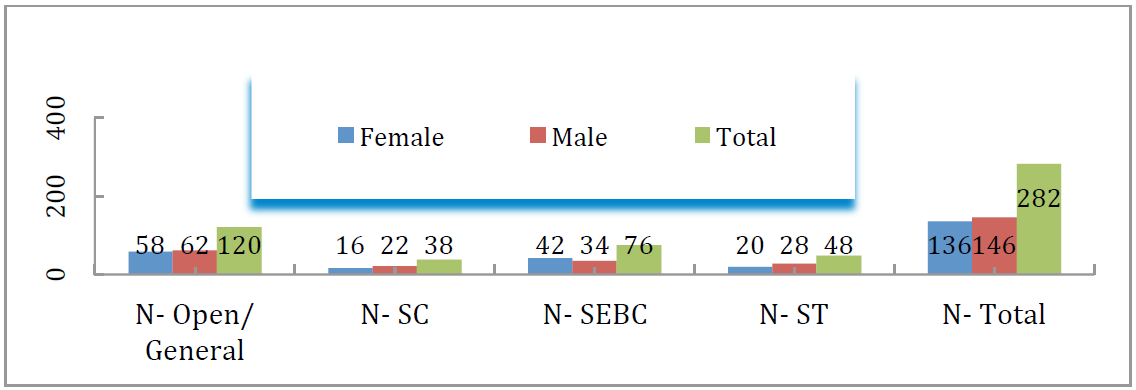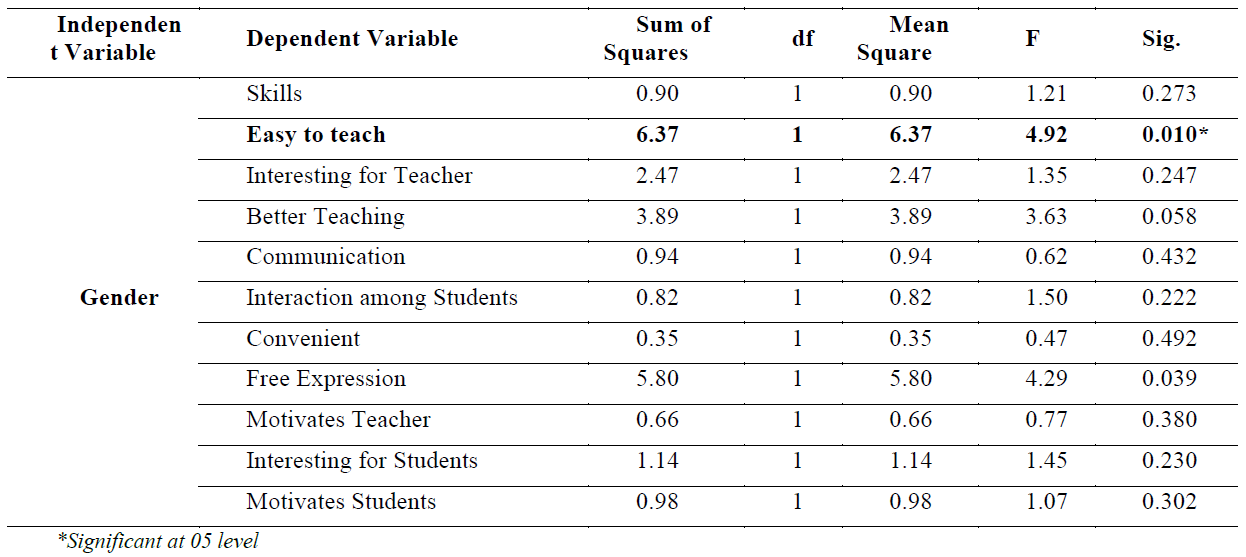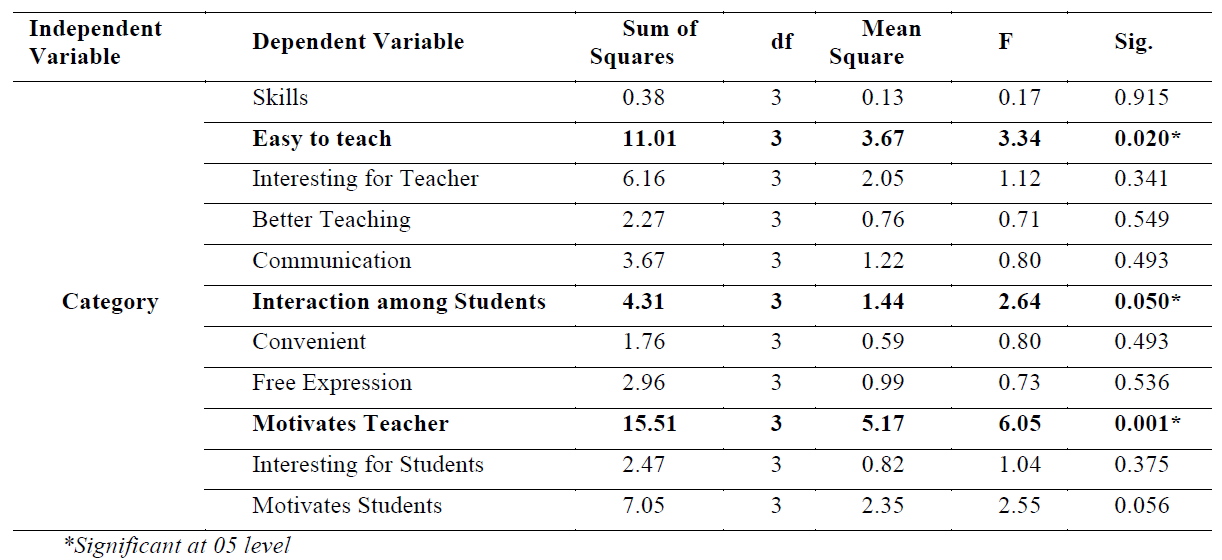Abstract
Blended learning is a quite debatable mode of learning in the world. The researcher aims in this study to investigate the views of EFL Secondary School Teachers on Blended Learning. In the present study EFL is an abbreviation for "English as a Foreign Language". EFL is defined as the language of students learning English as foreign language. In India Gujarati language speaking students learning English language then for them its known as EFL(English as a Foreign Language). It also aims to investigate the views of the EFL secondary teachers on blended learning. Total EFL teachers of HimatnagarTaluka, Gujarat State, India are included in this study. The sample will be selected randomly. The sample will be provided hard copy or soft copy of the questionnaire. India is an orthodox type of country where tradition matters a lot. In some part of India male dominates the social system hence EFL teaching from gender perspective may have different impact. In such a developing country, women are gaining good position in the education field in metro cities. India has a strong social, caste and creed system hence women from different strata may not have equal opportunity in small town and rural part. It is very interesting to study the views of EFL teachers on blended learning in the context of gender and category and the interactive effect of gender*category. Indian social system is based on categories like SC, ST, SEBC and Open/General.
Keywords: Blended learning;EFL and TEFLCategory
Introduction
Change is an essential part of life cycle. Changes in our life are affected by many factors like
political situation, economic growth, advancement in technology, etc. Technology has powerful impact
on life so Sethy, (2008) says “new findings are generated and become established at breathtaking speed”.
The impact of technology is so powerful that even the field of education is highly affected thus
Djiwandono (2013) writes, “Learning is no longer confined to the four walls and whiteboard of a
classroom”, because of various tools and resources that are used by the teacher to provide wider teaching-
learning knowledge. It is prime focus to see what changes are there in teaching of English as foreign
language. Teaching English as a second language is still centered on how to teach, not how to learn even
today in some parts of India. In India the method of chalk and talk is still in existence. The chalk and talk
method has certain limitations in learning the language. In India due to advancement in technology there
is impact of technology aided English as second language learning. We should agree that technology
aided learning also has some disadvantages like preventing individuals from socializing. It's because of
the absence of face-to-face communication (Azizan, 2010).In order to balance face-to face learning and
technology aided learning, we needed to find a new method and that is known as blended learning. In the
present study, it is endeavoured to study impact on EFL (English as a Foreign Language) due to the
increased use of blended learning, specifically at the secondary school teacher levels. It is tried to
determine some of the critical factors that affect the teachers views on using blended learning and also to
determine some of the factors that affect the teachers views on using blended learning. This is the first
effort to study the views of the EFL secondary teachers on blended learning. Total EFL teachers of
HimatnagarTaluka, Gujarat State, India.
Problem Statement
Blended Learning and EFL Secondary School Teacher
Research Question
The researcher aims to study the following mentioned questions-
1- Are there any significant differences between the views of EFL teachers on blended learning in
the context of their gender and category?
Limitation of the Study
1. Population of the study: this study was limited to secondary school teachers of EFL only.
2. This study is confined to HimatnagarTaluka only.
Paper Theoretical Foundation and Related Literature
Blended learning has been defined variously by academician of the world. The simple definition of
blended learning may be as the type of learning that synthesizes traditional face-to-face mode of learning
with technology enabled mode of learning. It derives benefits from both mode of learning. Lim, Morris,
and Kupritz (2007) write that it’s a learning method that has more than one way to enhance learning
outcomes with a low cost associated. So and Bonk (2010) believes that to design and apply blended
learning in order to deliver efficient content and knowledge with full support of students, you have to
make a clear integration between two components of the course (face-to-face and online). Lo, Johnson,
and Tenorio (2011) write that when students use blended learning their perception level of deep thinking and problem solving is higher. Moreover, this approach offers flexible resources which make the learning
environment more active, by providing students with new experiences and outcomes. Chen and Jones
(2007) mentioned that using web-based resources deepen students understanding of topics. Teachers
(those are ) new to blended learning fail to interact in online components with students because they feel
that they are doing the same thing twice (Nakazawa, 2009).Teachers should focus on the outcomes and
how to benefit more from the use of technology as a virtual extension of the classroom (Senior, 2010). It
may be possible that enhancing blends of both modes cause some changes to the teaching learning
experience but not a complete change. It is said that transforming blends of both modes results in a
complete major changes in the teaching and learning.Badawi (2009) studied the effectiveness of the
blended learning model in developing knowledge and performance knowledge and performance of EFL
prospective teachers. Results showed that the blended learning model surpassed the traditional model
group in developing pedagogical knowledge of prospective teachers. However, there were no significant
differences between the two groups in developing the pedagogical performance of prospective teachers.
Liu (2013) investigated blended learning in an Academic English Writing course (AEW) in terms of
course design, material development and presentation, assignment submission and grading, student
involvement, teacher reflection, and student evaluation in his study. Findings by Liu indicate that students
favoured and appreciated blended learning in many ways, such as increasing student-student and student-
teacher interactions, reducing or even eliminating communication anxiety, motivating them to become
(more) independent and autonomous learners, and enhancing their academic English writing ability.
Investigation by Djiwandono (2013) shows that the effectiveness of blended learning in vocabulary
lessons and the opinions of students about the blended learning experience. Findings showed an apparent
gain in students’ command of 5000-level English words. Surprisingly, they did not make a similarly
encouraging achievement in new words from the texts. Kuo, Belland, Schroder, and Walker (2014) tried
to investigate the relationship between student perceptions of three types of interaction and blended
learning course satisfaction. Results shows that students perceived interaction as important to their
learning experiences and were moderately satisfied in their blended learning course. It also revealed that
the personality of student is a major factor for interaction and satisfaction in this type of course design.
Aldalalah, & Gasaymeh (2014) tried to investigate the effects of locus of control and anxiety level on
Jordanian educational technology students’ perceived blended learning competencies and obstacles. The
results dhows that students with internal locus of control performed significantly better than external
locus of control students in blended learning competencies (Knowledge &Technological) and blended
learning obstacles. The findings also showed that moderate anxiety students performed significantly
better than low and high anxiety students in blended learning competencies (Knowledge &Technology)
and blended learning obstacles. It also concluded that there was no significant difference between the low
and high anxiety students in blended learning obstacles. The study of previous literature shows that many
studies have been conducted to explore the effectiveness of blended learning and how it affects
performance of teachers and students. The findings were in favour of blended learning and also showing
how it improves the performance of both.
Abbreviations
01 BL= Blended Learning
02 TEFL= Teaching of English as a Foreign Language.
03 EFL= English as a Foreign Language
04 ELF= English as a Lingua Franca
05 SC= Schedule Caste
06 ST= Schedule Tribes
07 SEBC= Socially and Economically Backward Class
08 Open/General= Those are not in SC/ST/SEBC are known as Open/General
Methodology
The aim of this research is to investigate the views of EFL teachers on Blended Learning so
quantitative data was collected using non standardized questionnaire having 11 questions. The non-
standardized, five-point-scale Questionnaire on the view of EFL teachers on blended learning (VETBL)
was developed and used in both on-line and off-line form. The researcher has tried to study all the
relevant information in the construction of the tool and also attempted to conduct personal interview with
experts in order to develop the insight for the construction of the tool. The suggestions provided by the
experts on the questionnaire were considered in the construction of the questionnaire. The research items
were based on five-point-scale (1 for SD= Strongly Disagree, 2 for D=Disagree, 3 for U=Uncertain, 4 for
A=Agree, 5 for SA=Strongly Agree) for each item on the questionnaire. The results for each scale were
computed through a calculation of the mean, standard deviation and percentage scores. The statistical
calculation provides the level of views of EFL teachers on BL in the following way:
1- Very Weak (V.W): Percentage from 00% to less than 20%.
2- Weak (W): Percentage from 21% to less than 40%.
3- Medium (M): Percentage from 41% to less than 60%.
4- High (H): Percentage from 61% to less than 80%.
5- Very High (V.H): Percentage from 80% to 100%.
Sample
Statistical Treatment
The researcher tried to investigate the of views of EFL teachers on BL by means of a descriptive
and analytical methodology. Quantitative research design was applied. The responses were generated in
the MS Excel csv format. The value of each item was calculated in MS Excel. The data was calculated in
ANOVA with the help of SPSS version 21. The effect of variables was analysed at 0.05 level and the
HOs were tested. The data is presented in % calculation in tabular form wherever necessary.
Analyses and Results
The researcher tried to find the answer of the question " Are there any significant differences
between the views of EFL teachers on blended learning in the context of their gender and category? The
researcher formulated three Hos for the above question.
In the following table, the sum of square, df, Mean square and F with sig. are shown for the effect
of the variable of gender on blended learning.

It is observed from the table above that the calculated value of male and female on blended
learning is 0.010 for component of
In the following table, the sum of square, df, Mean square and F with sig. are shown for the effect
of the variable of category on blended learning.

It is observed from the table above that the calculated values of category of teachers on blended
learning are 0.020 for the component of
affects the components:
In the following table, the sum of square, df, Mean square and F with sig. are shown for the effect
of the interaction of the variables like gender*category on blended learning.

It is observed from the table above that the calculated value of the interaction of gender*category
of teachers on blended learning is 0.005 for component of
interaction of gender*category of teachers on blended learning affects the components:
Discussion
After the intensive study on the views of EFL teachers on blended learning in the context of
variables like gender and category, it can be said that the teachers believes that they feel the English
courses easier to teach when applying BL in teaching. It is surprising to note that the teachers from
various categories like open/general, SC, SEBC and ST believes that blended learning activities allow
students to interact with each other in better way than the face to face mode of learning. It is also
concluded that the teachers from various categories also are of opinion that blended learning content
motivates them to teach better in competition with traditional mode of learning.
Conclusion
It is concluded that the teachers of EFL of HimatnagarTaluka of Gujarat State, India believes that
blended learning makes their activity of teaching more easy. The EFL teachers thinks that there is more
room for interaction because of blended learning that also results in the self-motivation to themselves.
The research can be summed up by saying that the teachers of EFL are not in favour of teaching-learning
activities in traditional mode but prefers blended learning mode.
References
- Aldalalah, O. A., &Gasaymeh, A. M. (2014). Perceptions of blended learning competencies and
- obstacles among educational technology students in light of different anxiety levels and locus of
- control. Contemporary Educational Technology, 5(3), 218-238. Retrieved from
- http://www.cedtech.net/articles/53/533.pdf
- Azizan, F. Z. (2010). Blended learning in higher education institution in Malaysia. Paper presented at
- Proceedings of Regional Conference on Knowledge Integration in ICT 2010 ,Kolej Universiti
- Islam Antarabangsa Selangor, Malaysia. Retrieved from
- http://library.oum.edu.my/oumlib/sites/default/files/file_attachments/odl-resources/4334/blendedlearning.pdf
- Badawi, M. F. (2009). Using blended learning for enhancing EFL prospective teachers’ pedagogical knowledge and performance. Online Submission, Paper presented at Learning & Language--The Spirit of the Age Conference, Cairo, Egypt. Retrieved from http://eric.ed.gov/?id=ED504993 Chen, C. C., & Jones, K. T. (2007). Blended learning vs. traditional classroom settings: assessing effectiveness and student perceptions in an MBA accounting course. The Journal of Educators Online,4(1). Retrieved from http://files.eric.ed.gov/fulltext/EJ907743.pdf
- Djiwandono, P. I. (2013). A blended learning approach to enhance college students’vocabulary learning.Electronic Journal of Foreign Language Teaching, Centre for Language Studies, National
- University of Singapore, 10(2), 210-220. Retrieved from http://e-
- flt.nus.edu.sg/v10n22013/djiwandono.pdf
- Lim, D., Morris, M., &Kupritz, V. (2007). Online vs. blended learning: differences in instructional outcomes and learner satisfaction.Journal of Asynchronous Learning Networks,11(2), 27-42.
- Retrieved from http://eric.ed.gov/?q=ONLINE+VS.+BLENDED+LEARNING%3a+DIFFERENCES+IN+INSTR UCTIONAL+OUTCOMES+AND+LEARNER+SATISFACTION+&id=EJ842695
- Liu, M. (2013). Blended learning in a university efl writing course: description and evaluation. Journal of Language Teaching and Research, 4(2), 301-309. Retrieved from http://www.academypublication.com/issues/past/jltr/vol04/02/10.pdf
- Lo, C. C., Johnson, E., &Tenorio, K. (2011). Promoting student learning by having college students participate in an online environment. Journal of the Scholarship of Teaching and Learning,,11(2), 1-15. Retrieved from http://josotl.indiana.edu/article/viewFile/1817/1814
- Nakazawa, K. (2009). Student engagement in online language learning: a case study examining the online delivery of tertiary language courses. The International Journal of Learning: Annual Review, 16(7), 405-414. Retrieved from file:///C:/Users/Administrator/Downloads/Publisher%20version%20(open%20access).pdf Senior, R. (2010). Connectivity: a framework for understanding effective language teaching in face-to-face and online learning communities. RELC Journal, 41(2), 137-147. Retrieved from file:///C:/Users/Administrator/Downloads/REL375775.pdf
- Sethy, S. S. (2008). Distance education in the age of globalization: an overwhelming desire towards blended learning. Turkish Online Journal of Distance Education, 9(3), 29-44. Retrieved from http://dergipark.ulakbim.gov.tr/tojde/article/view/5000102683/5000095779
- So, H. J., & Bonk, C. J. (2010). Examining the roles of blended learning approaches in computer supported collaborative learning (CSCL) environments: a delphi study. Educational Technology & Society, 13(3), 189-200. Retrieved fromhttp://www.ifets.info/journals/13_3/17.pdf
Copyright information

This work is licensed under a Creative Commons Attribution-NonCommercial-NoDerivatives 4.0 International License.
About this article
Publication Date
25 May 2017
Article Doi
eBook ISBN
978-1-80296-022-8
Publisher
Future Academy
Volume
23
Print ISBN (optional)
-
Edition Number
1st Edition
Pages
1-2032
Subjects
Educational strategies, educational policy, organization of education, management of education, teacher, teacher training
Cite this article as:
Patel, H. B. (2017). Blended Learning and EFL Secondary School Teacher. In E. Soare, & C. Langa (Eds.), Education Facing Contemporary World Issues, vol 23. European Proceedings of Social and Behavioural Sciences (pp. 790-797). Future Academy. https://doi.org/10.15405/epsbs.2017.05.02.96

